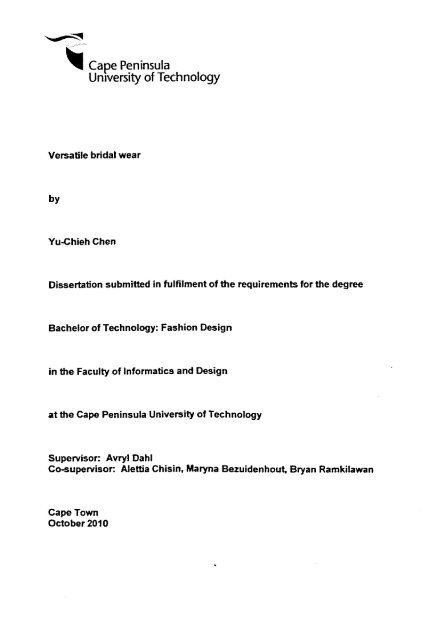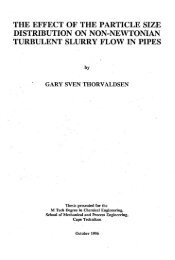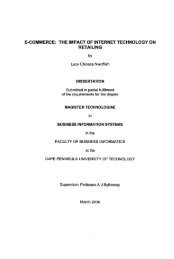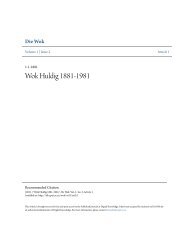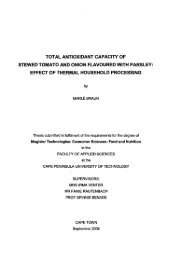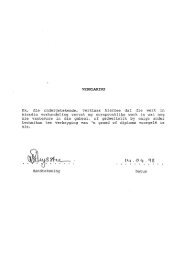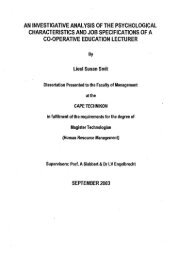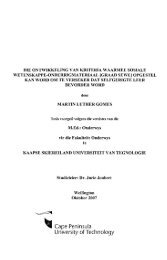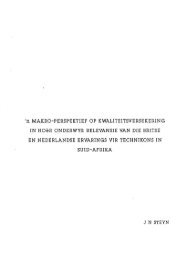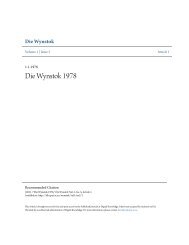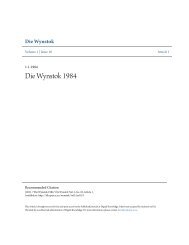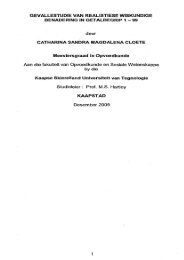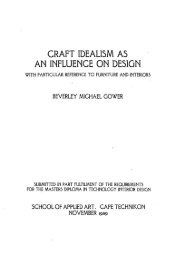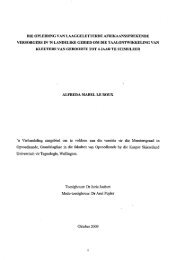Versatile bridal wear.pdf - CPUT | Digital Knowledge - Cape ...
Versatile bridal wear.pdf - CPUT | Digital Knowledge - Cape ...
Versatile bridal wear.pdf - CPUT | Digital Knowledge - Cape ...
You also want an ePaper? Increase the reach of your titles
YUMPU automatically turns print PDFs into web optimized ePapers that Google loves.
DECLARATION<br />
I, Yu-Chieh Chen, declare that the contents of this dissertation/thesis represent my own<br />
unaided work, and that the dissertation/thesis has not previously been submitted for<br />
academic examination towards any qualification. Furthermore, it represents my own opinions<br />
and not necessarily those of the <strong>Cape</strong> Peninsula University of Technology.<br />
Signed<br />
ii<br />
Date<br />
2010
ABSTRACT<br />
In the 19 th and zo" Century, products were manufactured with little concerns for the<br />
environment. The result of this was an over flowing of low quality products and a high<br />
elimination rate, especially in the fashion industry where constant change is the nature of the<br />
business. Particularly in <strong>bridal</strong> <strong>wear</strong>s, the sustainability is deficient and practicality is limited.<br />
<strong>bridal</strong> garments would only be wom once and are usually highly priced.<br />
The purpose of this research is to explore whether consumers are willing to contribute and<br />
make a difference to our environment by opting for versatile <strong>bridal</strong> <strong>wear</strong>. In order to obtain<br />
information regarding the <strong>bridal</strong> industry of <strong>Cape</strong> Town. a qualitative approach was applied to<br />
ensure that the end products will meet customer needs. Store visits and informal interviews<br />
were used as the primary methods. and Internet and magazines were used as secondary<br />
methods to gain relative information about the market.<br />
The information collected. regarding modem women's opinions on the concept of an<br />
interchangeable <strong>bridal</strong> range, current fashion trends and the concept of Slow Design, forms<br />
the foundation to the development of my range - versatile <strong>bridal</strong> <strong>wear</strong>. The entire range<br />
consists of 14 garment pieces that are interchangeable to form 6 or more looks. This allows<br />
the <strong>wear</strong>er to dress up according to their desires. As a result, lhese dresses are reusable<br />
and thus overcoming the problem of costly garments. which are only wom once.<br />
,<br />
iii
I wish to thank:<br />
ACKNOWLEDGEMENTS<br />
• Avryl Dahl, for her excellence gUidance and patience in the development of my work.<br />
• Maryna Bezuidenhout and Bryan Ramkilawan for their supervision on the<br />
development of my clothing range which fonms the practical component of this<br />
dissertation.<br />
• My parents for their financial support and constant encouragement with their best<br />
wishes<br />
• <strong>Cape</strong> Peninsula University of Technology that provided me a pleasant environment<br />
for my studies.<br />
iv
TABLE OF CONTENTS<br />
Declaration<br />
Abstract<br />
Acknowledgements<br />
THE PROPOSAL<br />
1. INTRODUCTION<br />
1.1 Background to the research problem<br />
1.2 Statement of research problem<br />
1.3 Significance to knowledgelknowledge gap<br />
1.4 Topic area<br />
1.5 Clarification of basic terms<br />
1.6 Objectives of the research<br />
1.7 Sub-questions<br />
2. UTERATURE REVIEW<br />
2.1 Previous/existing research<br />
2.2 Theoretical underpinning<br />
3. METHODOLOGY<br />
3.1 Approach<br />
3.2 Data co!leclion and analysis<br />
4. DEUNEATION OF THE RESEARCH<br />
5. SIGNIFICANCE OF THE RESEARCH<br />
6. EXPECTED OUTCOMES. RESULTS and CONTRIBUTIONS OF THE RESEARCH h<br />
7. REFERENCES<br />
CHAPTER ONE: INTRODUCTION<br />
1.1 The selling<br />
1.2 Purpose statement<br />
1.3 Sub-questions<br />
CHAPTER TWO: UTERATURE REVIEW<br />
2.1 Intraduction<br />
2.2 Slow design<br />
2.3 Existing practice<br />
2.4 Modularity<br />
2.5 Summary<br />
CHAPTER THREE: THE EVOLUTION OF WESTERN WEDDING GOWNS<br />
3.1 Introduction<br />
3.2 Medieval period<br />
3.3 18'" century<br />
v<br />
ii<br />
iii<br />
iv<br />
a<br />
a<br />
a<br />
b<br />
b<br />
b<br />
c<br />
d<br />
f<br />
g<br />
g<br />
g<br />
h<br />
1<br />
3<br />
4<br />
6<br />
6<br />
8<br />
9<br />
10<br />
11<br />
11<br />
11
3.4 19 t1l century<br />
3.5 Contemporary <strong>bridal</strong> gown<br />
3.6 Hybrid of past and present<br />
3.7 Summary<br />
CHAPTER FOUR: PRACTICAL COMPONENTS<br />
4.1<br />
4.2<br />
4.3<br />
4.4<br />
4.4.1<br />
4.4.2<br />
4.4.3<br />
4.4.4<br />
4.4.5<br />
4.4.6<br />
4.5<br />
4.6<br />
Introduction<br />
Field/approach and method<br />
Data analysis/Findings<br />
Products<br />
Design 1<br />
Design 2<br />
Design 3<br />
Design 4<br />
Design 5<br />
Design 6<br />
Relevancy of product with theory<br />
Summary<br />
CHAPTER FIVE: MARKET FEASIBIUTYIRECOMMENDATIONS<br />
5.1<br />
5.2<br />
5.3<br />
5.4<br />
5.5<br />
5.5.1<br />
5.5.2<br />
5.5.3<br />
5.5.4<br />
56<br />
Introduction<br />
Bridal industry and markets in <strong>Cape</strong> Town<br />
Competition<br />
Anticipated future market potential<br />
Recommendation and business strategy<br />
Advertising and promotion<br />
Distribution channels<br />
Pricing<br />
Operations<br />
Summary<br />
CHAPTER SIX: CONCLUSION<br />
6. Conclusion 34<br />
REFERENCES<br />
7. References<br />
vi<br />
13<br />
14<br />
18<br />
18<br />
19<br />
19<br />
19<br />
21<br />
23<br />
24<br />
25<br />
26<br />
27<br />
28<br />
29<br />
29<br />
30<br />
30<br />
31<br />
31<br />
31<br />
31<br />
32<br />
32<br />
32<br />
33<br />
36
LIST OF FIGURES<br />
Figure 1.1: Simple extravagance, Denim and fabric tiered skirt, 2009. 3<br />
Figure 2.1: Junky styling, hooded suit scarf, 2010. 8<br />
Figure 2.2: Diego Gonzalez King, Tona chair, 2007. 9<br />
Figure 2.3: MAC, desktop set, 2010. 10<br />
Figure 3.1: AJexandrina Victoria, court gown, 1854. 12<br />
Figure 3.2: Mary Woodworth Bradley, 1935 wedding gown, U.S.A. 14<br />
Figure 3.3: Monique Lhuillier, Bridal Spring 2011. 15<br />
Figure 3.4: Vera Wang, Black wedding gown, 2009. 16<br />
Figure 3.5: Vera Wang, Fall <strong>bridal</strong> collection, 2010. 16<br />
Figure 3.6: Vera Wang, 2010 Spring <strong>bridal</strong> collection, 2009. 17<br />
Figure 3.7: Vera Wang, 2010 Spring <strong>bridal</strong> collection, 2009. 17<br />
Figure 4.1: Yu-Chieh Chen, August 2010, Cowl neck body suit with asymmetrical 23<br />
tiered skirt I<br />
Figure 4.2: Yu-Chieh Chen, August 2010, Strapless asymmetrical dress with floor 24<br />
length skirt<br />
Figure 4.3: Yu-Chieh Chen, August 2010, Strapless dress with pleated styling 25<br />
Figure 4.4: Yu-Chieh Chen, August 2010, Strapless bodice with ruffle skirt 26 1<br />
Figure 4.5: Yu-Chieh Chen, August 2010. Single shoulder corset with ruched skirt I 27<br />
Figure 4.6: Yu-Chieh Chen, August 2010, Column dress with detachable draping 28<br />
vii
IL-- I<br />
THE PROPOSAL
1 INTRODUCTION<br />
THE PROPOSAL<br />
1.1 Background to the research problem<br />
Fashion in South Africa is growing, where more and more local designers are<br />
introducing their designs to the stage of fashion. With the concems of environment<br />
and eco-friendly awareness, to design sustainably should become the first priority<br />
when it comes to designing. With these emerging designers, it is exactly the right<br />
timing for them to implement sustainable and Slow Design theory into their designs in<br />
order to lengthen the lifespan of products.<br />
1.2 Statement of research problem<br />
A wedding is one of the most important days in one's life and when it comes to the<br />
wedding gown, every woman would like to have the most elegant one and keep it<br />
after the wedding to remember the memorable day, but due to the nature of its<br />
purpose, they often have a very short lifespan regarding the frequency of <strong>wear</strong>ing it,<br />
and are highly priced.<br />
When looking at the industry of these garments. a gown costs approximately R5000<br />
or more. In the case where customers purchased these gowns, instead of renting,<br />
they are often packed away after their initial purpose.<br />
1.3 Significance to knowledgelknowledge gap<br />
In the 19'" and 20'" century where ptoducts had been manufactured without any<br />
a
concerns regarding the resources and the environment, it is crucial that a front line<br />
producer, designer, to implement the practice of sustainability.<br />
Although re-designing on an existing object had been practiced in design fields such<br />
as furniture and fashion, examples of these practices on <strong>bridal</strong> <strong>wear</strong> is not very<br />
common yet.<br />
1.4 Topic area<br />
My main focus here is to design a range targeting in women <strong>wear</strong>, more precisely,<br />
<strong>bridal</strong> <strong>wear</strong>, that is versatile and will be able to be seen as another outfit, other than its<br />
original intention.<br />
My aim is to design wedding dresses that can be converted to another look so that it<br />
can be worn after the initial of purchase to prolong the lifespan of the garment thus<br />
make a contribution to sustainable design.<br />
1.5 Clarification of basic terms and concepts<br />
Sustainability: the ability of being long lasting<br />
Slow design: the idea of making a linkage between designer. the product of which<br />
they produce and the end user.<br />
1.6 Objectives ofthe research<br />
The purpose of this research is to explore whether the consumer is willing to<br />
contribute and make a difference to our environment by opting for a versatile <strong>bridal</strong><br />
<strong>wear</strong> and to what extent, regarding their financial ability, can they contribute. This<br />
b
esearch will be targeting on South African women, as well as women from eastern<br />
country, Taiwan, of different age groups in order to gain information from a wider<br />
range potential customers.<br />
1.7 Sub-question<br />
In order for the reader to have a better understanding of this document. sub-questions<br />
are formed which will be answered in each chapters.<br />
The sub-questions are as follows:<br />
1.7.1 How can slow design theory contribute to prolonging the lifespan of a<br />
designer's products?<br />
1.7.2 What influences of western fashion have affected my upcoming <strong>bridal</strong> range?<br />
1.7.3 How will the concept of "reuse" be incorporated into my designs?<br />
c
2 UTERATURE REVIEW<br />
2.1 Previous/existing research<br />
The Slow design theory which was developed by Alastair Fuad-Luke was derived<br />
from the slow food movement. which was founded in 1989. by Carlo Petrini.<br />
The basic theory of "Slow" is to "allow linking products and their producers to their<br />
places of production and to their end-users who. by taking part in the production chain<br />
in different ways. become themselves co-producers". as well as encouraging<br />
consumers to slow down their paces to minimize the ecological footprint (Rossi et a/.•<br />
2006:1 ).<br />
Alastair Fuad-Luke applied the same concept but in the design point of view. he<br />
pointed out few examples of what a sustainable designer should keep in mind:<br />
1. Components of designed object should be able to reused and recycled<br />
2. Focusing on the real need of the consumer. rather than market driven needs<br />
3. Encourage modularity of the product so that it is possible to repair or reuse in<br />
order to improve functionality<br />
4. educate clients and users by encouraging sustainable literacy and graphicacy<br />
(Fuad-Luke, 2004)<br />
Designs today are produced to fulfill non-stop consumer needs. most products are<br />
manufactured to fulfill the desire and not the actual needs. In order to increase the<br />
revenue of a business. the manufacturing of these products are not intended for long<br />
lasting purpose (Fuad-Luke. 2004),<br />
Product are so economically driven that the real meaning of the products disappears.<br />
d
as Claudia Dona expressed: "we live in a world overflowing with our own productions,<br />
a world in which objects besiege us, suffocate us, and very often distance us from one<br />
another both physically and mentally.....they make us forget how to feel, to touch, to<br />
think. Accustomed to living in a unifonn light, we have grown oblivious of the shadows<br />
and fearful of the dark" (Fuad-Luke sited in Dona, 2004). To design responsibly has<br />
become an obligation of all designers.<br />
2.2 Theoretical underpinning<br />
According to the several outcomes of Fuad-Luke's Slow Design theory, "encourage a<br />
reduction in economic, industrial and urban metabolisms, and hence consumption, by:<br />
serving basic human needs; designing for people first. commercialization second;<br />
re-awakening individual's own design potential; and catalyzing social transfonnation<br />
towards a less materialistic way of living" (Fuad-Luke, 2004).<br />
,<br />
f
3 METHODOLOGY<br />
3.1 Approach<br />
The main goal of this research is to create alternative options for potential customers<br />
to become part of the group who is aware of the damage humans are causing to<br />
environment.<br />
I aim to produce '<strong>bridal</strong> <strong>wear</strong> packages' where additional garments will be sold with<br />
the wedding dress so that the <strong>wear</strong>er can explore their own way of <strong>wear</strong>ing the dress.<br />
hence. extend the life of the garment.<br />
3.2 Data collection and analysis<br />
My method of investigation will be through store visits, internet, magazines and<br />
informal interviews with both local and foreign women from different age group<br />
ranging from age 20 to 35 years.<br />
I will analyse the information of which I am intending to research on to understand<br />
whether consumers are willing to accept the concept of reusing their garments that I<br />
am intending on implementing into my range. Feedbacks from the research will be<br />
analysed and useful information will be taken into consideration when I design my<br />
range.<br />
4 DEUNEATION OF THE REAEARCH<br />
My research on the information will be based on <strong>bridal</strong> store visits. internet.<br />
magazines and informal interviews with women from <strong>Cape</strong> Town, as well as relatives<br />
in the eastern countries, Taiwan. through e-mail. facebook and msn tools. The reason<br />
g
for gathering information on women from different countries is to gain wider aspect on<br />
modem women's viewpoint on what they think about the concept of which I am<br />
intending on placing into my emerging range.<br />
5 SIGNIFICANCE OF THE RESEARCH<br />
Through this research I would like to make my design more meaningful than just a<br />
range of tedious wedding dresses, which will be completed by combining the essence<br />
of Slow Design theory into my range. The ultimate end product will be versatile<br />
dresses that have a second life which will lengthen the lifespan of it that will ultimately<br />
reduce the high elimination rate of products.<br />
6 EXPECTED OUTCOMES, RESULTS and CONTRIBUTIONS OF THE<br />
RESEARCH<br />
I am expecting to produce versatile dresses that are able to transform into a second<br />
outfit in order to prolong the lifespan of the garment to reduce the consumption of<br />
resources.<br />
h
7 REFERENCES<br />
Clark. H. 2008. Slow + fashion- an oxymoron or a promise of the future? Fashion<br />
Theory. 12(20): 427<br />
Core 77. 2010. Portfolio. Coroflot. [Online] Available:<br />
http://www.coroflot.com/diegogonzalezking. [14 March 2010]<br />
Fuad-Luke, A. 2005. Slow theory. Slow Design. [Online] Available:<br />
http://www.slowdesign.org/slow1heory.html. [10 March 2010]<br />
Rossi. F. Simeone. G. Recchia. M. 2006. Slow + Design I Manifesto + Abstracts. In:<br />
Via Vivaio. International seminar on slow approach to distributed economy and<br />
sustainable sensoriality. Milan
1'--- THE DISSERTATION<br />
1<br />
,
1.1 The setting<br />
CHAPTER ONE<br />
INTRODUCTION<br />
The purpose of this research is to explore whether consumers are willing to contribute and<br />
make a difference to our environment by opting for versatile <strong>bridal</strong> <strong>wear</strong>. This research will be<br />
targeting South African and foreign women from different age groups in order to gain<br />
information with regards to potential customers.<br />
Fashion in South Africa is growing as an industry, particularly where more and more local<br />
designers from various cultures are introducing their designs to the fashion stage. The<br />
primary concern for designers should be towards design sustainability and a trend towards<br />
eco-awareness (as a result of growing environmental concerns). Now is the time for the<br />
emerging designers to implement sustainable design and Slow Design through the production<br />
of garments that promotes versatility (where the entire look is matched with various optional<br />
garment pieces to create a different look for other occasions, such as honeymoon, weekend<br />
or day <strong>wear</strong>).<br />
For a designer to be part of 'Slow Design", they should focus on aspects such as:<br />
Designing products that can to be reused;<br />
Focusing on real customer needs and the practicality of the designs;<br />
- Educate clients and users about sustainability by printing written or graphical<br />
information on clothing tags;<br />
- Encouraging the disassembly of the products so that it is possible to repair and reuse<br />
in order to improve functionality.<br />
A wedding is one of the most important days in one's life and when it comes to the wedding<br />
gown, every woman would like to be confident in her gown. However. wedding gowns often<br />
1
have a very short lifespan, in terms of the duration of which they are worn.<br />
In the wedding industry, gowns cost approximately R5000 or more each and in the case<br />
where customers purchase these gowns, instead of renting, they are often packed away after<br />
their initial purpose and rarely used again.<br />
In the 19'" and 20'" century, where products were manufactured without any concerns for the<br />
resources and the environment, it is crucial that a designer, who is in the front line of any<br />
production, implement the concepts of sustainable design and "Slow Design'.<br />
Although redesigning an existing object has been practiced in design fields such as furniture<br />
and fashion, examples in the <strong>bridal</strong> <strong>wear</strong> industry are not very common, and it is in this aspect<br />
that I hope to make a contribution.<br />
The reusing and redesigning of existing garments has been practiced in the past. In casual<br />
<strong>wear</strong>, for example, new life can be given to an old pair of denim jeans by removing the legs<br />
portion (leaving the waist and the hip areas) and replacing it with woven fabric to end up with<br />
a denim skirt, as shown in figure 1.1.<br />
2
Figure 1.1: Simple extravagance , Denim and fabric tiered skirt, 2009 .<br />
(Simpleextravagance .com , 2009)<br />
My main focu s, however, is with an exclusive product and a niche market. My aim is to design<br />
a range, targeting smart women, more precisely brida l <strong>wear</strong>, which can be converted to<br />
everyday <strong>wear</strong>. The aim is to produce a range of garments that are versatile, multi-functional<br />
and interchangeable.<br />
The transformation practice will be done in either of the following methods:<br />
• Gowns will be paired with a shawl , bolero , pants or various garment pieces that can be<br />
matched with the dress itself so that it appears to be another 100 , or<br />
• The gown itself will have different components, for example bows or panels, that can be<br />
removed or adjusted thus it can be worn repeatedly where it was previously designed for<br />
only a sing le, specific occasion .<br />
3
1.2 Purpose statement<br />
My aim is to design garments that can be converted into another look so that they can <strong>wear</strong> it<br />
after the initial purchase to prolong the lifespan of the garment thus making a contribution to<br />
sustainable design.<br />
1.3Sub-Questions<br />
Throughout this document, each chapter will provide new information to the reader, and will,<br />
at the same time answer the sub questions that are derived from the main problem. The<br />
sub-questions are:<br />
• How can the Slow Design theory contribute to prolong the lifespan of a designer's<br />
products?<br />
• What influences of westem fashion have affected my upcoming <strong>bridal</strong> range?<br />
• How will the concept of "reuse" be incorporated into my designs?<br />
Chapter 2 is the literature review. This chapter clarifies the theory of Slow Design on which<br />
this document is based. Examples of designs/designers that had adopted the same concept<br />
of the theory from various design disciplines will be mentioned.<br />
Chapter 3 provides a background for my inspirations. This chapter has information and<br />
explanations on how wedding gowns have changed since the medieval period up to the<br />
present.<br />
Chapter 4 outlines the practical approach on how information that was acquired, through<br />
various ways of information gathering methods, were analysed and then eventually combined<br />
into a <strong>bridal</strong> range. Al the same time, images of my design are included for a better<br />
understanding of the range.<br />
4
Chapter 5 analyses the market feasibility of my <strong>bridal</strong> range. Aspects such as description of<br />
the industry and market, competition, future market potential and recommendations of<br />
business strategies to promote my products are taken into account.<br />
Chapter 6 is the conclusion<br />
5
2.1 Introduction<br />
CHAPTERTWO<br />
UTERATURE REVIEW<br />
In this chapter, a theoretical framework will be provided based on the Slow Design theory by<br />
Alastair Fuad-Luke. The concept of modular design will also be discussed. and subsequently,<br />
existing practices that have adopted these methods will be touched on.<br />
The Slow Design theory, developed by Alastair Fuad-Luke, was derived from the slow food<br />
movement, which was founded in 1989. by Carlo Petrini.<br />
The basic theory of "Slow" is to "allow linking products and their producers to their places of<br />
production and to their end-users who. by taking part in the production chain in different ways,<br />
become themselves co-producers" (Rossi et al, 2006:1), as well as encouraging consumers<br />
to slow down their paces to minimize the ecological footprint.<br />
2.2 Slaw Design<br />
Alastair Fuad-Luke applied the same concept but from a design point of view. He pointed out<br />
that a sustainable designer should keep the following in mind:<br />
1. Components of the designed object should be able to be reused and recycled.<br />
2. Focus on the real needs of the consumers. rather than market driven needs.<br />
3. Encourage modularity of the product so that it is possible to repair or reuse in order to<br />
improve functionality.<br />
4. Educate clients and users by encouraging sustainable literacy and graphiCS.<br />
5. Question and challenge the status quo surrounding existing products.<br />
6. Create maximum benefits of wellbeing to the possible audience.<br />
6
7. At all stages of the product life cycle, be sure to eliminate the use of toxic or hazardous<br />
substances that will be a threat to humans and other forms of life.<br />
8. Maximize product benefits to socio-cultural potential clients<br />
(Fuad-Luke, 2004)<br />
These days, products are manufactured to meet consumers' high demand. Most products are<br />
manufactured to fulfill the desires of people and not their actual needs. Products are not made<br />
in a way for it to last long. because by doing this. consumers will need to replace the broken<br />
product with a new one, which will only benefit the company's revenue.<br />
Products are so economically driven that the real meaning of the products fades away.<br />
Designers should put the economic factors aside temporarily. while designing, so that the<br />
design can achieve the real needs of the consumer and the environment. because the theory<br />
of slow design was meant to refocus on individuals, socio-cultural community and<br />
environmental well-being (Fuad-Luke, 2004).<br />
The problem of the over-flowing of low quality products as well as the rapid elimination and<br />
replacement of old designs exists. I would like to solve this problem by designing garments<br />
targeting a niche market. which is the <strong>bridal</strong> <strong>wear</strong>, that will be able to last longer by creating<br />
good quality designs and allow them to be interchangeable and versatile so that there is a<br />
possibility for it to be worn again.<br />
Extending the lifespan of a garment can be approached in two ways: Firstly, re-style existing<br />
products. or secondly, adopt the slow design theory. where the designer should. at the first<br />
stage of producing products, keep in mind of how it can be reused at a later stage.<br />
My method of reusing these garments is to allow them to be interchangeable within the<br />
'package' which the garment is going to be sold with. In this pad(age. brides can interchange<br />
garments, transforming it into a casual look so that they are ready to depart on honeymoon<br />
•<br />
7
after the wedding without worrying what they should <strong>wear</strong>. The new transformed outfit can<br />
also be wom to other occasions<br />
2.3 Existing practice<br />
The re-styling and re-using of unwanted garments, in order for them to be wom again, has<br />
long been practiced. Junky Styling, a Londo n based retailer in the United Kingdom allows the<br />
customer to bring in old but quality garm ents for them to re-style second life (Clark cited in Kay,<br />
2006 ). Figure 2 .1 is an examp le of a scarf that is transformed from an unwanted suit.<br />
Figure 2.1: Junky styling, hooded suit scarf, 2010. (Junky styling, 2010)<br />
In the furniture industry, an Argentine designer. Diego, produced a fum iture piece called Tona<br />
Chair, (Figure 2.2). This multipurpose fum iture piece can either be used as a chair or as a<br />
table by flipping it over, the user can then place it as they desire. Therefore the lifespan of this<br />
fum iture piece will be longer compared to the one that only serves one purpose (Core 77,<br />
20 10).<br />
,<br />
8
TABLE OR CHAIR?<br />
Figure 2.2 Diego Gonzalez King, Tona chair, 2007 . (Coroflot.com , 2010)<br />
During the 18'" and 19'" cen tury, the Industrial Revolution enabled companies to manufacture<br />
products efficien tly in order to meet the vast demand of the consumers. In this period, the<br />
relationship between the designers and the product owners simply lost connection (Clark,<br />
2008). However, living in the 21 st century, to design responsibly is not just an interest for<br />
design ers anymore. It has become an imperative practice that we should all participate in, in<br />
order to maintain and to better the planet. Claudia Dona expressed:<br />
·We live in a world overflowing with our own productions, a world in which objects<br />
besiege us, suffocate us, and very often distance us from one another both physically<br />
and mentally.....they make us forget how to feel, to touch, to think. Accustomed to living<br />
in a uniform light, we have grown oblivious of the shadows and fearful of the dark."<br />
(Dona, 2004)<br />
2.4 Modularity<br />
A key point of slow design is to produce modular designs . This means allowing the product to<br />
9
e composed of various elements. The advantage of modular design is that it enables the<br />
users to replace the broken elements instead of the entire product.<br />
An example of a modular design would be a computer (Figure 2.3). A computer is a group of<br />
electronic elements that are assembled to serve a function. A traditional personal computer<br />
consists out of a screen, mouse, keyboard, CD-Rom, hard drive, speaker etc. Wh en any of<br />
these element s malfunction it can be replaced with a product that serves the same func tion.<br />
2.5 Summary<br />
. --<br />
Figure 2.3 MAC, desktop set , 2010. (yahoo.com, 2010)<br />
According to the several outcomes of Fuad-Luke's slow design theory, slow designs<br />
"encourage a reduction in economic, industrial and urban metabolisms, and hence<br />
consumption. This is achieved by serving basic human needs, designing for people first and<br />
commercialization second, re-awakening individual's own design potentials, and cata lyzing<br />
social transformation towards a less materialistic way of living" (Fuad-Luke, 2004). and this is<br />
in line with the aims of this research.<br />
10
3.1 Introduction<br />
CHAPTER THREE<br />
THE EVOLUTION OF WESTERN WEDDING GOWNS<br />
This chapter will familiarize the readers with the history of the wedding gown, more<br />
specifically with regards to how it has changed through time, from the medieval period to the<br />
21 st century. Historical examples provided will be linked to how I approached my design range<br />
and I will attempt to address the question of how the influences of westem fashion have<br />
affected my upcoming <strong>bridal</strong> range.<br />
3.2 Medieval period<br />
Royal marriage was an alliance between two countries, which often consisted of political<br />
importance, therefore young brides would dress up excessively so that they looked<br />
outstanding and magnificent. This was done to uphold the image of her country and to<br />
impress the people from the groom's country. Brides often wore gowns encrusted with<br />
precious gems such as diamonds, sapphires, rubies, pearls and emeralds. These gowns<br />
were symbols of wealth and status.<br />
During this period, colours that were used in wedding gowns were rich colours such as red,<br />
purple and black. These colours were difficult to acquire and were therefore more precious,<br />
expensive and also reflected higher levels of wealth.<br />
3.3 is''' Century<br />
The white gown, which was made popular by Queen Victoria, has maintained its position<br />
through to the 21 st century. Figure 3.1 is an image of Queen Victoria in 1840, she wore a white<br />
silk and Honiton lace, with a matching head veil, of which the train measured 18 feet. This<br />
•<br />
11
impressed the audience and soon became the fashion of wedding gowns (Wedding gowns.<br />
2009).<br />
Figure 3.1: A1exandrina Victoria. court gown. 1854. (china.com. 2010)<br />
White, or any variation of white. symbolized the purity, innocence and virginity of a bride; as a<br />
result. it was favoured dUring this time period. Blue was also a popular colour due to its<br />
association with the Virgin Mary, which symbolized purity and eternal love. Brides who wore<br />
blue believed that their husbands would always be true and loyal to them. Even if their gown<br />
was not blue, they would include blue accessories to be worn with the wedding dress. Since<br />
then this has become a tradition.<br />
Wedding gowns of brides in the lower section of the social hierarchy would be dresses that<br />
were usually being wom as daily <strong>wear</strong>. Embellishing the dress with ribbon and laces changed<br />
it into a Wedding dress.<br />
12
3.4 19 th Century<br />
Wedding dresses in this period followed what was in fashion at that time. It was the time<br />
where brides first wore gowns that revealed their knees. However. this style did not last long<br />
because it was seen as inappropriate for a church service.<br />
The interruptions of the FIrst and Second World War. which impacted all levels of society,<br />
apparently changed the style of wedding gowns. Owing to the limitation of resources, clothes<br />
were rationed and uniforms could be seen everywhere. After the war period when fashion<br />
.<br />
bloomed again people were eager to <strong>wear</strong> luxurious and voluminous wedding gowns.<br />
Different styles of wedding gowns came into play after the world war. These included the<br />
dropping of the waistline in the1920's to its usual length. During the 1930's the style was<br />
padded shoulders, big sleeve features, sweet heart shaped neckline (refer to figure 3.3), high<br />
waist empire fine dress and the extravagant circular skirt (DressFinder.com. 2006).<br />
•<br />
13
Rgure 3.2: Mary Woodworth Bradley, 1935 wedding gown, U.S.A. (Victoria and Albert<br />
3.5 Contemporary <strong>bridal</strong> fashion<br />
Museum, 2010)<br />
Bridal gowns have changed into various shapes, lengths and colours in time. Designer<br />
Monique Lhuillier, a Rlipina fashion designer which is based in Los Angeles, has in her latest<br />
collection designed a short wedding dress (Rgure 3.4), which is predicted to be seen more<br />
often at weddings.<br />
In most of the traditional weddings, white gowns were, and still are, the main colour to be worn,<br />
which represents the purity of the marriage. Nowadays, fashion designers, such as Vera<br />
Wang, have brought the colour black into herdesigns (FIQure 3.5; 3.6; 3.7 and 3.8), which has<br />
become a fashion statement and a whole new view on wedding gowns (4marry.net. 2010).<br />
14
Figure 3.3: Monique Lhuillier, Bridal Spring 2011.2010 (Monique Lhuillier.com, 2010.)<br />
In most of the traditional weddings, white gowns were, and still are , the main colou r to be worn ,<br />
wh ich represent s the purity of the marriage. Nowadays, fashion designers , such as Vera<br />
Wang, have brought the colour black into her designs (Figure 3.5; 3.6; 3.7 and 3.8), which has<br />
become a fashion statement and a whole new view on wedd ing gowns (4marry.net, 2010).<br />
15
Figure 3.4: Vera Wang, Black wedding gown, 2009 . (Verawang.com. 2010)<br />
Figure 3.5: Vera Wang, Fall <strong>bridal</strong> collection, 2010. (Verawang.com, 2010)<br />
16
Figure 3.6: Vera Wang, 2010 Spring <strong>bridal</strong> collection , 2009. (Verawang.com, 2010 )<br />
Figure 3.7: Vera Wang, 2010 Spring <strong>bridal</strong> collection, 2009. (Verawang.com, 2010 )<br />
17
3.6 Hybrid of past and present<br />
With the information that I have acquired from the primary research. interview with a <strong>bridal</strong><br />
boutique owner. also a qualified photographer. Michael Liu, there is evidence that weddings<br />
are shifting to a more casual ambiance regarding the colour. silhouette and the entire mood of<br />
wedding ceremonies.<br />
Keeping in mind the shift of wedding traditions towards a more casual approach. and the<br />
global economic situation, I would like to produce ten to fourteen garment pieces, of various<br />
lengths and colours. but keeping the white shade fabrics as my main focus. and adopting<br />
those forecasted colours and styles into my entire <strong>bridal</strong> collection. hereby acknowledging<br />
Slow Design and the principles of sustainability by being versatile and interchangeable.<br />
3.7 Summary<br />
Bridal gowns evolved over time as well as the colour and silhouette of the gowns. I would like<br />
to use the examples from the past as a guide for designing my upcoming <strong>bridal</strong> range.<br />
Inspired by the challenging colours of wedding gowns nowadays and the variety of fabrics that<br />
are available, I will design my range and take into consideration the essence of the slow<br />
design theory. I will create versatile <strong>bridal</strong> ranges enabling the brides to mix and match<br />
garments pieces within the <strong>bridal</strong> package to create their own outfit according to their<br />
personal preferences. Product development will be the focus of the next chapter.<br />
18
4.1 Introduction<br />
CHAPTER FOUR<br />
PRACTICAL COMPONENTS<br />
The purpose of this chapter is to outline the practical approach on how I gathered and<br />
analysed my information. It furthermore explains how the concepts from the Slow Design<br />
theory. which is to design products that can be reused. were implemented into my range of<br />
clothing.<br />
4.2 Field/approach and method<br />
I am focusing on fashion design, which is the field of my study. In order to obtain information<br />
regarding the <strong>bridal</strong> industry in <strong>Cape</strong> Town. a qualitative approach was applied. I used store<br />
visits and informal interviews as primary methods. and Internet and magazines as secondary<br />
methods to gain relative information about the market<br />
Stores that were visited in <strong>Cape</strong> Town were Sophia Boutique. Wedding time <strong>bridal</strong> boutique.<br />
Jagadi in Claremont and Bride & Co. at Century City. From these stores my aim was to<br />
acquire information on style. price and consumer behavior regarding their preferences.on<br />
wedding dresses.<br />
4.3 Data analysislFindings<br />
The results collected from various sources, which included store visits, informal interviews,<br />
intemet and magazines. were used as a guideline of the aspects I should consider when<br />
designing my ranges. The results have shown that aspects such as style. price and lifestyle<br />
have changed over time. which leads to the change, and transformation of wedding dresses.<br />
•<br />
19
The feedback from Michael, the owner of Sophia <strong>bridal</strong> boutique, pointed out, which wedding<br />
dresses in his store were the best sellers and which ones were difficult to sell. The differences<br />
are usually in the style and colour of the dresses. Michael has been the owner of the <strong>bridal</strong><br />
boutique for 8 years. He explained that some customers do not know what shape of wedding<br />
dress suits them best, so the assistant in the store has to assist and give advice to the<br />
customer.<br />
Informal interviews were done with 20 women from the age of 20 to 32 years. Questions that<br />
were asked include:<br />
Will they purchase wedding dresses with the concept of reusing it after the wedding?<br />
What do they think about the idea of wedding dresses being sold as a package?<br />
How much are they willing to spend on wedding dresses?<br />
Which colour, style and shape do they prefer?<br />
The results from the interview were positive; it showed that 70% of the women interviewed<br />
liked the idea of a versatile wedding dress. The same amount of money could rather be spent<br />
on buying a wedding dress that is versatile and more practical than buying a wedding dress<br />
that can only be worn once.<br />
Colour-wise, 85% chose white as their wedding dress, whereas 15% would attempt to dress<br />
in daring colours such as black, or colours of soft pastel shades such as peach, purple and<br />
blue that is currently in fashion. The budget for the Wedding dress varies from R3000 to<br />
R8000, depending on the cost of their venues and other expenses for the wedding.<br />
Regarding the style and silhouette, the majority opts for dresses that will cover their flaws and<br />
suit their budget The length of the dresses varies according to the type and venues of the<br />
wedding. for example, a shorter dress will be more favorable for a beach Wedding. However,<br />
the ultimate choice of the style and silhouette depends on personal preference.<br />
•<br />
20
Information sourced from magazines and Internet showed that there is a shift from the<br />
traditional church wedding towards a more casual wedding held in hotels or the outdoors. For<br />
outdoor venues such as a beach wedding dresses need to be clean cut and convenient to<br />
move in.<br />
Therefore, in order to accomplish these requirements and simultaneously apply the Slow<br />
Design theory to support my thesis. Jreasoned that to produce versatile wedding dresses with<br />
a concept of selling it as a "<strong>bridal</strong> package", would offer a convenient way of dressing to the<br />
bride.<br />
Designing wedding dresses that are versatile increases the frequency of <strong>wear</strong>ing these<br />
garments, in other words. these outfits satisfies the initial need of the customer (for wedding<br />
purpose). After the wedding it can be worn to other occasions when they replace it with the<br />
pre-designed garment piece that was meant to substitute an item of the Wedding dress in the<br />
<strong>bridal</strong> package. This achieves the essence of the Slow Design theory, which supports the<br />
principle of extending the lifespan of an object, where products should be reusable and the<br />
design should focus on the customer needs rather than market driven needs.<br />
4.4 Products<br />
The range consists of 14 interchangeable garment pieces. Each outfit is supported by images,<br />
followed by descriptions of the design, the fabric choice, colours and the styling. Images are to<br />
be seen later in this chapter.<br />
These garments include:<br />
1 x draped body suit,<br />
1 x bolero,<br />
1 )( tailor jacket.<br />
•<br />
21
2 x pants.<br />
2 x floor length dress<br />
2 x mid-thigh length dress<br />
2 x corsets<br />
3 x long skirt,<br />
While designing these garments. I have kept in mind how it can be paired with other garment<br />
pieces to create alternative outfits for each individual. The customer can either <strong>wear</strong> it with the<br />
alternative piece that is designed for the garment. or even match it with garments that they<br />
already own. in this way; it enables the original wedding dress to be worn more frequently.<br />
Designs 1 to 5 are created for the customer to mix and match with garment pieces within<br />
these groups. whereas design 6 is set to be unchangeable.<br />
•<br />
22
4.4.1 Design 1<br />
Figure 4.1 Yu-Chieh Chen. August 2010, Cowl neck body suit with asymmetrical tiered skirt<br />
Soft pastel shades are the main trends in the clothing industry as well as in <strong>bridal</strong> <strong>wear</strong> in<br />
2010 and will be in 2011 ; therefore I use this soft salmon georgette as the colour for this dress.<br />
This outfit consists of two separate pieces. The bodice is a double-layered cowl neck body<br />
suit with snap button at the gusset. It is wom with a tiered and flared skirt with a train.<br />
The length of the skirt is knee length at the front with a tra in at the back . The skirt can be<br />
substituted with a black. high-waist pencil skirt that is made from peach skin fabric.<br />
23
4.4.2 Design 2<br />
Figure 4.2 Yu-Chieh Chen. August 2010, Strapless asymmetrical dress with floor length skirt<br />
This is a thigh-length asymmetrical layered dress that has a separate floor length column skirt.<br />
The strapless dress contains four layers of fabrics. which are: lining. boning. Dutch satin and<br />
chiffon. The boning layer keeps the dress in shape and ensures a better posture. On the outer<br />
layer. chiffon pieces have been randomly placed on various satin layers to tone down the<br />
shine of Dutch satin. so that it creates a soft feeling for the entire dress . The dress is<br />
completed with an invisible zip at a slightly v-shaped centre back. White fabric was chosen for<br />
this dress. as shades of white are still the mainstay of wedding dresses.<br />
The skirt piece can be replaced with pre-paired pants that are made from cotton fabric with<br />
slight stretch. Details of these pants are the pin tucks which are focused at the bottom leg<br />
portion.<br />
24
4.4.3 Design 3<br />
Figure 4.3 Yu-Chieh Chen, August 2010, Strapless dress with pleated styling<br />
Wedd ing dresses are becom ing more and more casual as not all wedd ings are held in a<br />
formal church. Alternatively, people opt for outdoor or beach weddings . In this case, shorter<br />
wedd ing dresses are more favourab le.<br />
Taking into consideration the wind at the beach , this dress is designed to be simple yet<br />
elegant. Instead of adopting any excess fabrics that are inconvenient for windy beach weather,<br />
there is pleated detail at the right hand side of the bust. Fabric used here consists of iron-on<br />
silver beads all over, thus breaking the plain Dutch satin fabric. The same fabric that is used<br />
for pleating is used under the bust. The fabric is double folded and runs under the bust to the<br />
centre back. The dress is d osed with an invisible centre back zip and has three strings of<br />
crysta l beads that run horizontally above the zip, providing some exciteme nt from the back<br />
view.<br />
25
4.4.4 Design 4<br />
Figure 4.4 Yu-Chieh Chen, Augu st 2010, Strap less bodice with ruffle skirt<br />
Inspired by the daring colour for a wedding dress, I have chosen black for this dress . This<br />
outfit is separated into bodice and skirt, the same fabric were used for both pieces.<br />
Boning supports the bodice and has ruche chiffon layered at the bust section . The skirt has<br />
various layers of ruffles with a mixture of embroidered lace and chiffon fabric sewn onto<br />
Bonita satin which is the major fabric used for the skirt. The embroidered lace and chiffon<br />
adds a subtle romance to the skirt and interacts with the bodice .<br />
The bodice can be worn with a bolero and tapered trousers, as shown in f'!lure 4.4. The fabric<br />
used for the bolero is cation ic chiffon; it has a slight sheen that creates a luxurious finishing.<br />
The tapered trousers that can be worn with the bolero have a low crotch and loose fit by the<br />
hip area, followed by double folded hems .<br />
26
4.4.5 Design 5<br />
Figure 4.5 Yu-Chieh Chen . August 2010. Single shoulder corset with ruched skirt<br />
This is a two-piece wedd ing dress. corset bod ice and full skirt. The corset hugs the body<br />
perfectly with boning support. At the left hand side of the shoulder. handmade<br />
three-dimensional flowers of various sizes are sewn to fill up the shou lder piece as a<br />
decorative purpose to the basic corset. This is followed by the full length asymmetrical skirt.<br />
the skirt consists of four layers. which are lining, Coco satin , gathered chiffon and ruche wh ich<br />
creates interesting dimensions. Handmade flowers are sewn randomly onto the ruche.<br />
The skirt can be replaced with the pants that were mentioned in 4.2.2.<br />
27
4.4.6 Design 6<br />
Figure 4.7 Yu-Chieh Chen. August 2010. Column dress with detachable draping<br />
This dress is fitted at the bust and waist but with a soft and floaty skirt. which is similar to<br />
Grecian style clothing. The bust area is emphasized with gathered chiffon. The chiffon fabrics<br />
are cut into strips and are twisted to form a spaghetti look. Then they are sewn at the edge of<br />
the bust and brought to one shoulder then to the back.<br />
The draped chiffon that falls to the ground is a detachable hooked-on piece that can be<br />
removed . which will leave the dress with a clean finishing.<br />
28
4.5 Relevancy of product with theory<br />
To apply the concept of reusability, that is associated with the principle and practice of Slow<br />
Design, I have applied the information with regard to the current trend in <strong>bridal</strong> <strong>wear</strong>, colour<br />
and style into my designs. At the same time I have kept in mind how the garments can be<br />
matched with other garment pieces within my range in order for these garments to be reused<br />
thus overcoming the problems of costty garments, which are only worn once. These garments<br />
allow the bride to dress up in a garment that was once particularly meaningful in her life and<br />
makes them usable for other occasions.<br />
4.6 Summary<br />
To attain the concept of re-usability that was mentioned in the Slow Design theory from my<br />
previous chapters I have applied the information, such as the current trends in <strong>bridal</strong> <strong>wear</strong>,<br />
colour and style, which I obtained through my research, into my designs. At the same time I<br />
had to keep in mind how the garments can be matched with other garment pieces within my<br />
range enabling these garments to be reused so that it solved the problem of costly garments,<br />
which are only worn once. These garments simultaneously allow the customer to dress up in<br />
a garment that was once especially meaningful in her life for other occasions.<br />
•<br />
29
5.1 Introduction<br />
CHAPTER FIVE<br />
MARKET FEASIBIUTYI RECOMMENDATIONS<br />
In this chapter I will be explaining the market feasibility of the products that I am producing. As<br />
all feasibility studies investigate and identify potential problems. I will focus on aspects such<br />
as the description of the industry and market. competition. future market potential and<br />
recommendations of business strategies on how I will go about promoting my products.<br />
5.2 Bridal industry and markets in <strong>Cape</strong> Town<br />
Statistics has shown that there is an increase in the number of marriages over the past 10<br />
years. In other words. more people are getting married and the <strong>bridal</strong> market is growing (My<br />
digital life. 2010).<br />
The <strong>bridal</strong> industry in <strong>Cape</strong> Town is a large market. as wedding expositions takes place each<br />
year at various places in <strong>Cape</strong> Town. Some examples are: The Garden Route wedding expo.<br />
Canal Walk <strong>bridal</strong> fair and The <strong>Cape</strong> Town wedding festival. With all these different exposition<br />
events. it proves that the <strong>bridal</strong> industry is a huge market and has the potential of improving.<br />
When researching the current local providers of wedding dresses on the Internet, the result<br />
easily reaches 20 to 30. Therefore it is important for your products be noticeable amongst the<br />
various providers. From the information gathered. most of the <strong>bridal</strong> dresses are priced quite<br />
high. whether they are from chain stores or designer labels. these dresses easily exceed R<br />
5000 per garment Although one can understand the exclusivity of a designer label. the prices<br />
which the customer is paying is really too high.<br />
•<br />
30
5.3 Competition<br />
As one can see from the number <strong>bridal</strong> <strong>wear</strong> companies who take part in various exhibitions<br />
that are held in <strong>Cape</strong> Town. and advertisements which designers placed in fabric stores. this<br />
is a very competitive market. I do not intend to compete with large chain stores such as Bride<br />
& Co. I would rather prefer to create dresses that let the customer feel confident and provide<br />
personal advice and styling for each individual.<br />
In addition. I will design extra garment pieces that can replace the skirt of the wedding dress.<br />
adding an extra bolero. jackets or pants to create another outfit transforming it into a more<br />
convenient outfit for other occasions. By doing this. it adds value to the dress because it offers<br />
versatility.<br />
5.4 Anticipated future market potential<br />
The dresses I produce have the ability to facilitate convenience by reducing time spent<br />
pondering on what to <strong>wear</strong> after the wedding ceremony. The bride can instantly take off the<br />
skirt and change into a pre-designed pair of classy pants or a romantic skirt to create a whole<br />
new outfit from the original wedding dress.<br />
My dresses will be produced in limited quantities and sold in packages and reduce anxiety for<br />
the brides. helping them with what to <strong>wear</strong> after the wedding. This prolongs the lifespan of a<br />
dress that was meaningful to them on onty one occasion. because they can <strong>wear</strong> it again after<br />
the wedding ceremony.<br />
5.5 RecommendationsIBusiness strategy<br />
5.5.1 Advertising and promotion<br />
31
The Intemet is a very popular tool to advertise and spread information. The number of<br />
advertisements that pop up during the period of time that one browses through the Intemet is<br />
quite high. I am planning to open a blog and publish information on Face book about my<br />
business. Photos of dresses will be available to the customers to browse through.<br />
Furthermore, I will have brochures at fabric stores to increase publicity and inform potential<br />
customers about the products that I offer. Promotional-wise, I will offer coupons to customers<br />
who purchased dresses and reward them with discounts on accessories that I produce as a<br />
sideline.<br />
5.5.2 Distribution channels<br />
I am planning to use the Intemet as part of my advertising tool so that when customers see<br />
the dress they want, they can come to the retail store, which I will be leasing in Claremont,<br />
<strong>Cape</strong> Town, to have their measurements taken and dress fitted. Once the dress fits property,<br />
they can purchase the product. By this means I will distribute my dresses directly to the<br />
customer.<br />
5.5.3 Pricing<br />
Pricing ofthe product depends on the costs of raw materials, but the cost of designing, pattern<br />
making and sewing will also be included. The cost price will be increased by approximately<br />
300% after adding up all the costs of raw material. labour and overheads.<br />
5.5.4 Operations<br />
Although Internet marketing will be my method of promoting my products, I will also require a<br />
store for potential customers to fit their dresses. I hope to rent approximately 20 square<br />
metres of floor space that is located on the second or third floor of a building, in order to lower<br />
32
my monthly expense. because the rent costs less than on the first floor.<br />
All materials will be purchased from the local fabric stores. My business focuses on a niche<br />
market therefore it is unnecessary to bUy large amounts of raw materials overseas.<br />
5.6 Summary<br />
The results of researching the current <strong>bridal</strong> market enabled me to extensively understand the<br />
other products that my products are competing with. To compete with stores that offer similar<br />
products. I plan to provide one-to-one consultations so that I understand the requirements of<br />
each customer. In addition, wedding dresses are designed in such a way so that they are<br />
interchangeable which provides convenience. The above-mentioned will be achieved by<br />
renting retail space where customers can fit their dress. The Internet will be used as<br />
marketing tool to complete the entire plan of promoting my clothing range.<br />
33
dresses that fits in with the current <strong>bridal</strong> trend, suits the lifestyle of 21" century women, and<br />
combine the essence of the Slow Design theory.<br />
,<br />
35
REFERENCES<br />
Chen, Y. & Liu, M. 2009. [Interview with Michael Uu on 24 May 2010J. <strong>Cape</strong> Town<br />
(Unpublished).<br />
Clark, H. 2008. Slow + fashion- an oxymoron or a promise of the future? Fashion Theory.<br />
12(20): 427<br />
Core 77, 2010. Portfolio. Carat/at. [Online]. Available:<br />
http://www.coroflot.comldieqogonzalezking. [14 March 2010)<br />
Fuad-Luke, A. 2004. Slow theory. Slow Design. [Online]. Available:<br />
http://www.slowdesign.orglslowtheorv.html. [10 March 2010)<br />
Junky styling, 2010. Hooded suit scarf, Junky styling. [Online]. Available:<br />
htto:/Iwww.junkvsMing.co.uk?in-store-now. [10 March 2010)<br />
King, D.G. 2007. Tona chair. Coronot. 2010. [Online]. Available:<br />
http://www.coroflot.comldiegogonzalezking. [14 March 2010)<br />
Monique Lhuillier.com, 2010. 2011 Spring. Bridal. [Online). Available:<br />
http://www.moniguelhuillier.com<br />
Rossi, F. Simeone, G. Recchia, M. 2006. Slow + Design I Manifesto + Abstracts. In: Via Vivaio.<br />
Intemational seminar on slow approach to distributed economy and sustainable sensoriality.<br />
Milan<br />
Simpleextravegance, 2009. Clothing, simple extravagance. 2009. [Online]. Available:<br />
http://simpleextravagance.comlindex.php?main page=index&cPath=60 107<br />
Wang, V. 2009. Black wedding gown, 2009. [Online]. Available:<br />
htto:/Iwww.<strong>bridal</strong>wave.tv/2009/11/galleryverawa.html. [2010/05/19)<br />
Wang, V. 2010. Fall <strong>bridal</strong> collection. [Online]. Available:<br />
htto:/lwww.verawangonweddings.comlfashioniGownCollection.aspx?Catalog=VWOW<br />
Fashion Content&SubCateqorv=Bridal- Fall 2010. [2010/05119)<br />
Wedding gowns, 2009. A1exandrina Victoria wedding. Wedding that made history; [Online).<br />
Available: htto:/Iw-weddinggowns.comlthe-weddinq-gown-that-made-historv. [2010/05119)<br />
Yanko design, 2010. Tona chair, Diego Gonzalez King. [Online). Available:<br />
htto:/Iwww.coroflot.comlpubliclindividual file.asp?from url=true&portfolio id=73n51&individ<br />
ual id-172802. [10 March 20101<br />
•<br />
36
Yahoo.com.tw. 2010. Apple iMac. Yahoo. [Online]. Available:<br />
http://buy.yahoo.com.tw/gdsale/gdsale.asp?gdid=2305985<br />
•<br />
37


